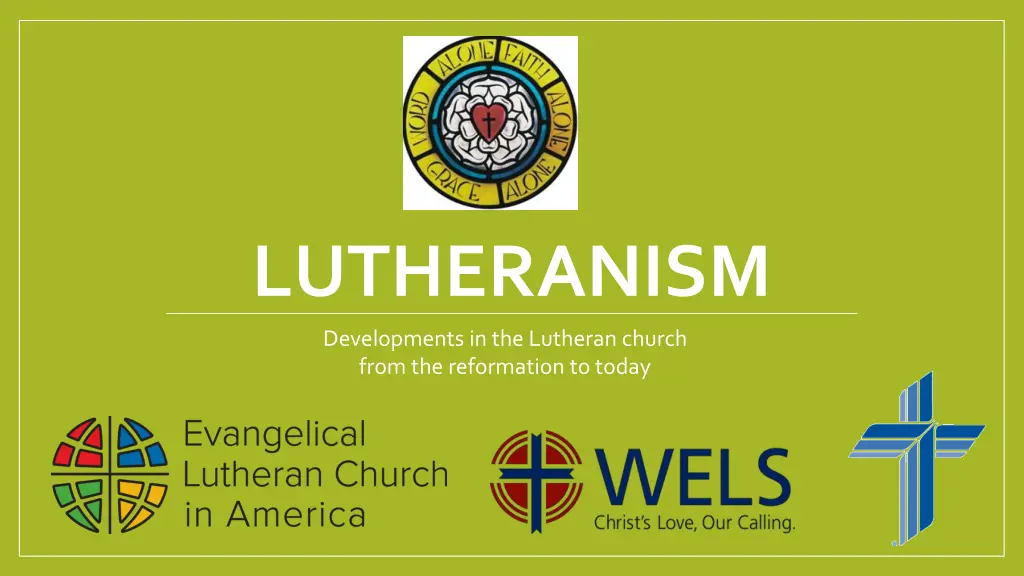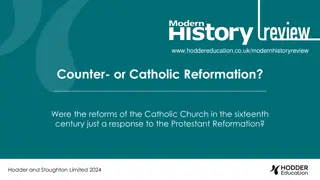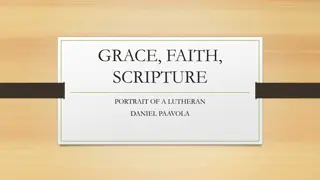
Lutheran Church Developments: Reformation to Present
Explore the growth and key aspects of Lutheranism from the Reformation era to the current times, including its global presence, major synods, beliefs, and historical background. Discover what it means to be Lutheran and how Lutheranism evolved from Martin Luther's separation from the Catholic Church.
Uploaded on | 1 Views
Download Presentation

Please find below an Image/Link to download the presentation.
The content on the website is provided AS IS for your information and personal use only. It may not be sold, licensed, or shared on other websites without obtaining consent from the author. If you encounter any issues during the download, it is possible that the publisher has removed the file from their server.
You are allowed to download the files provided on this website for personal or commercial use, subject to the condition that they are used lawfully. All files are the property of their respective owners.
The content on the website is provided AS IS for your information and personal use only. It may not be sold, licensed, or shared on other websites without obtaining consent from the author.
E N D
Presentation Transcript
LUTHERANISM Developments in the Lutheran church from the reformation to today
Statistics Lutherans are among the largest branches of Protestants, having an estimated 81 million adherents globally. Areas of concentration include Germany and parts of Northern Europe, USA, Brazil, Indonesia, Ethiopia, Eritrea, Madagascar, Tanzania and Namibia. There are over 40 different Lutheran Synods in North America, though the largest three represent the majority of Lutherans. Those are the Lutheran Church- Missouri Synod (LCMS), the Evangelical Lutheran Church in America (ELCA), and the Wisconsin Evangelical Lutheran Synod (WELS). In total, there are an estimated 5-7 million Lutherans in the United States. According to 2025 Synod Reports, the ELCA has 2.8 million members, the LCMS has 1.7 million members, and WELS has 330,000 members.
What does it mean to be Lutheran? Lutheranism today is characterized by subscription to the Book of Concord, namely: Augsburg Confession and its Apology The Smalcald Articles Treatise on the Power and Primacy of the Pope Small and Large Catechisms Formula of Concord Three Ecumenical Creeds (Apostles, Nicene, Athanasian) Lutheranism can also be defined by belief in the three Solas from the Reformation: Sola fide- Faith alone , Sola gratia- Grace alone , Sola scriptura- Scripture/Word alone
Historical overview Lutheranism takes after Martin Luther, the reformer who broke from the Catholic Church in 1517. Lutheranism was recognized in 1555 with the Peace of Augsburg that ended fighting between Lutherans and Catholics in the Holy Roman Empire. However, the peace failed to prevent further fighting, leading to the Thirty Years War (1618- 1648). Lutheranism first migrated to America in the 1640s with an official congregation in the New England area in 1649. The Saxon Lutherans (who would later establish the LCMS) immigrated in 1838-1839.
Historical Overview (pt.2) When Lutheranism moved to America, one of the big challenges facing the church was the lack of church structure and supervision over individual Churches as was common in Europe. This led to the development of Synods (literally means to walk together ). In America, the formation of Synods would become the mode of how churches would relate to one another, establishing a common belief.
Quia vs Quatenus One of the big decisions of these new Lutheran Synods in America was their connection with their Reformation roots. How would they view the Lutheran Confessions? Quia -Some Synods would subscribe to the whole Book of Concord because it was a faithful and true explanation of Scripture. Quatenus -Many Synods would subscribe to the Book of Concord insofar as it was a faithful and true explanation of Scripture. The issue with a Quatenus subscription is that it leaves open the changing of church teaching on the whim of human reason. If a church teaching wasn t seen as favorable, then it could be tossed out.
Main Beliefs Scripture is the only norm and rule of faith. Tradition, reason, or any other source is considered secondary to Scripture. Lutherans recognize only 66 books of the Bible, excluding the Apocryphal books (1 Esdras, 1 & 2 Maccabees, Tobit, etc.) Lutherans are the origin of discussing the Law-Gospel distinction of Scripture. Lutherans teach only two sacraments (Baptism and Lord s Supper) A Sacrament is defined as something commanded by God, attached with a promise of blessing, and has a physical element. Salvation is by grace alone, through faith alone. Ancillary to this is that man is wholly sinful, unable to save himself.
Main Differences between Synods ELCA LCMS WELS Congregational: centralized Synod structure Bible is inerrant Only ordains men, women are restricted from serving in all church roles and from voting in congregational matters. Congregational: Synod structure is less homogenous offering array of beliefs in individual congregations Believes the bible isn t fully inerrant Ordains women Support LGBTQIA+ Congregational but more centralized Synod structure to assure doctrinal consistency Bible is inerrant Only ordains men, women restricted from being Pastor, but can serve in other roles. Traditional Progressive
Modern Comparison & Challenges At the end of each future study, I will lay out how we as Lutherans compare with varying denominations. Since this week IS Lutheranism, there isn t anything to compare. However, there are many challenges facing the Lutheran Church today as can be seen from the wide split in beliefs between synods. While some Synods might be closer in beliefs than others, the sad reality is we don t agree on fundamental teachings of Scripture. Next time, we will study Roman Catholicism as we dive into the various branches of Christianity.




